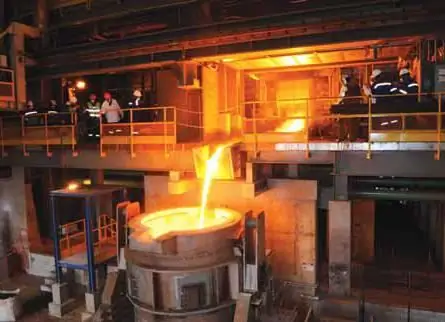2026 Author: Howard Calhoun | [email protected]. Last modified: 2025-01-24 13:10:35
A match is a small wooden stick with a hardened mixture of flammable chemicals at one end. When it is rubbed against the side surface of the box, both contacting surfaces are heated. Enough heat is generated to cause a small flame.
Wood requirements
Wood for making matches must be porous enough to absorb the required amount of chemicals, and flexible so as not to break when rubbed against the boxes. At the same time, it should be easy to handle. These conditions are best met by aspen and white pine.
In Russia, mainly aspen grater safety matches are produced. They require a box side surface coated with a special composition of chemicals to ignite.

Production process
First, blanks are made from wood - sticks of a certain length and section. Next, the so-called straws are soaked in a solution of ammonium phosphate. This is done to prevent smoldering after the burning of the incendiary head, as the match head is called. After drying and sandingworkpieces are installed in the matrix of the transport drum, with the help of which all subsequent operations of industrial production are performed.
The blanks are heated and one end is dipped in paraffin. When ignited, it will provide a small amount of additional fuel for combustion, so that the flame generated by friction is sufficient to ignite the match. Once the paraffin fumes have burned off, the ammonium phosphate impregnated in the straw will prevent further burning. An adhesive mixture of the chemical composition of the match head is applied on top.
Grating matches
They ignite only when the head is rubbed against the side of the box specially designed for ignition. The composition of the chemicals has remained unchanged since the invention of the Swedish match in 1855: sulfur, potassium chlorate (Bertolet s alt KClO3), manganese oxide (pyrolusite) and fine glass powder.
These are the main components that provide combustion. Bertoletova s alt is an oxidizing agent, a supplier of oxygen, without which the flame will quickly go out. Pyrolusite is used to slightly reduce the temperature of the flame. Sulfur is highly flammable and supports combustion. Glass powder is added to increase friction.

The composition of the match head changed during this time only in a quantitative ratio, mainly due to the addition of inert materials to control the burning rate: zinc white, chrome peak. The mixture also includes animal glue, which holds all the components together. Sometimes water-soluble dyes are added.
Compositionmixtures on the side of the box: antimony sulfide and red phosphorus, to which inert substances are also added so that when one match is lit, the entire box does not flare up. It can be the same glass powder, gypsum, kaolin, red lead.
Combustion chemical reaction
Conditionally, the chemical reaction of ignition of a match during friction against the boxes can be expressed by the equation
16KClO3 + 3P4 С3 16 Kcl + 9 SO 2.
The main chemical elements are berthollet s alt, which is part of the match head, and red phosphorus, the reaction releases sulfur dioxide with a characteristic odor.

And without a box to ignite?
If certain conditions are met, a match can be ignited by rubbing against a surface not covered with a special composition for the box. For this, a different chemistry of the match head is used.
Starless - that's what they are called. They are able to ignite when rubbed against any rough surface. They are produced in the USA and England, mainly for military needs, under the name strike anywhere. What matches are made of, which are often shown in American films, is of interest to many.
The ignition head is made from two different formulations of chemicals and contains P4S3 phosphorus sesquisulfide, a non-toxic compound with sulfur.
A glue mixture of sulfur, Bertolet s alt, rosin, antimony trisulfide, phosphorus sesquisulfide and inert and stabilizing components is applied directly to the paraffin-soaked straw.
After drying the baselayer on the incendiary head, the top layer of the composition of the match head is applied, containing the same components, but in different proportions: a greater amount of phosphorus sesquisulfide, berthollet s alt, fine glass powder.
When the ignition head is rubbed with heat, the highly reactive chemical ignites with a blue flame and ignites the rest of the ignition head components.

In addition to the familiar household matches (in five-centimeter boxes), matches are produced designed for specific purposes:
- fireplace and gas - larger for ease of use;
- for kindling cigars and pipes;
- household - in large packages;
- all-weather - for lovers of extreme types of recreation; ignite even in the most adverse weather conditions;
- signal - burn bright, from a distance noticeable flame; magnesium is added to the composition of the match head mixture.
Recommended:
Bronze is an alloy composition. The chemical composition of bronze

Many people know about bronze only that sculptures and monuments are cast from it. In fact, this metal is undeservedly deprived of popular attention. After all, it was not in vain that in the history of mankind there was even a Bronze Age - a whole era during which the alloy occupied a dominant position. The qualities possessed by an alloy of copper and tin are simply indispensable in many industries. It is used in the manufacture of tools, in mechanical engineering, casting church bells, and so on
Job description of the head of the VET. Head of VET: duties, instructions

The construction of any facility, especially a large one, is a complex process that requires organization and preparation at all stages. Project documentation, raw materials, labor and energy resources must be used in the right quantities at different periods in accordance with the construction schedule
Steel: composition, properties, types and applications. Composition of stainless steel

Today, steel is used in the vast majority of industries. However, not everyone knows that the composition of steel, its properties, types and applications are very different from the production process of this product
How were matches made before and how are they made today? Swedish matches

The article is devoted to the history of the creation of matches - from their very first prototypes to modern ones. It also tells about the famous Swedish matches, the evolution of the chemical components of the match head and stickers for the box
Maximum and average weight of a ram at different ages: an overview of different breeds

Sheep are very popular farm animals. Sheep are bred in almost all corners of the world, including in unfavorable natural areas. These animals were domesticated a very long time ago - in the 6th-7th centuries BC. In addition to unpretentiousness, farmers also attribute the ability to quickly gain muscle mass with low feed costs to the pluses of sheep

